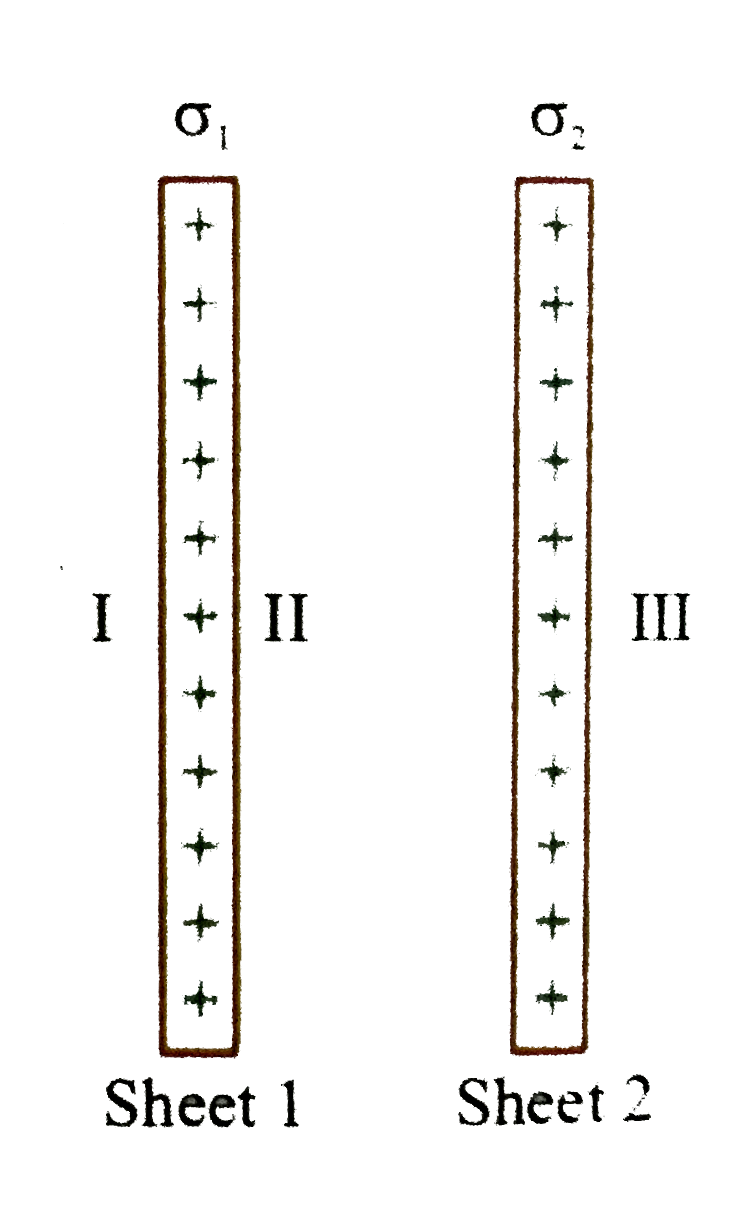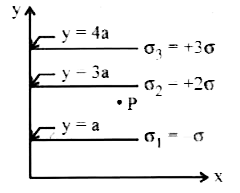There are two large parallel metallic plates S1 and S2 carrying surface charge densities σ1 and σ2 respectively (σ1>σ2) placed at a distance d apart in vacuum. Find the work done by the electric field in moving a point charge q at distance a(a<d) from S1 towards S2 along a line making an angle π/4 with the normal to the plates.
The correct Answer is:W=(σ1−σ2)qa√2∈0
Electric field near a large metallic plate is given by E=σ/ε0. In between the plates the two field will be in opposite direction. Hence,
Enet=σ1−σ2ε0=E0 (say)
Now, W=(q) (potential difference)=q(E0acos45∘)
(q)(σ1−σ2ε0)(a√2)=(σ1−σ2)qa√2ε0
Topper's Solved these Questions
- MISCELLANEOUSBook:ALLENChapter:MISCELLANEOUSExercise:LINKED COMPREHENSION TYPE
Explore 3 Videos
- KINEMATICS (MOTION ALONG A STRAIGHT LINE AND MOTION IN A PLANE)Book:ALLENChapter:KINEMATICS (MOTION ALONG A STRAIGHT LINE AND MOTION IN A PLANE)Exercise:BEGINNER S BOX-7
Explore 8 Videos
- PHYSICAL WORLD, UNITS AND DIMENSIONS & ERRORS IN MEASUREMENT Book:ALLENChapter:PHYSICAL WORLD, UNITS AND DIMENSIONS & ERRORS IN MEASUREMENT Exercise:EXERCISE-IV
Explore 8 Videos
Similar Questions
There are two large parallel metallic plates S1 and S2 carrying surface charge densities σ1 and σ2 respectively (σ1>σ2) placed at a distance d apart in vacuum. Find the work done by the electric field in moving a point charge q at distance a(a<d) from S1 towards S2 along a line making an angle π/4 with the normal to the plates.
View SolutionTwo unifromly charged infinitely large planar sheet S1 and S2 are held in air parallel to each other with separation d between them . The sheets have cahrge distaribution per unit area σ−1 and sifma−2 )C m^(-2)) , respectively with σ1>σ2. Find the work done by ther electric field on a point charge Q that moves from from S1 towards S2 along a line of bength a (a<d) making an angle π4 with the normal to the sheets. Assume that the cahrge Q does not affect the cahrge distributions of the sheets .
View Solution
Knowledge Check
Two parallel plane sheet 1 and 2 carry uniform charge densities σ1 and σ2 as shown in fig.electric field in the region marked II is (σ1>σ2)
 A−(σ1+σ2)2ε0B−(σ1σ2)2ε0C(σ1+σ2)2ε0D(σ1−σ2)2ε0
A−(σ1+σ2)2ε0B−(σ1σ2)2ε0C(σ1+σ2)2ε0D(σ1−σ2)2ε0Two infinitely long parallel sheets having surface charge densities +σand−σ respectively are separated by a small distance. The electric field in the region between the plates is
A0Bσ2∈0Cσ∈0D2σ∈0Three non-conducting large parallel plates have surface charge densities σ,−2σand4σ respectively as shown in the figure. The electric field at the point P is
 Aσε0Bσ2ε0C3σ2ε0D3σε0
Aσε0Bσ2ε0C3σ2ε0D3σε0
Three infinite long plane sheets carrying uniform charge densities σ1=−σ,σ2=+2σandσ3=3σ are placed parallel to the x-z plane at y=a,y=3aandy=4a as shown in the figure. What is the electric field at point 'P' ?

View SolutionTwo infinitely large sheets having charge densities σ1andσ2 respectively (σ1>σ2) are placed inbetween two plates such that there is no effect on charge distribution on plates. This charge is moved at an angle of 45∘ with horizontal towards plate having charge density σ2, through a distance a lt d. Find work done by electric force.
View SolutionTwo uniformly charged large plane sheets S1 and S2 having charge densities σ1 and σ2 (σ1>σ2) are placed at a distance d parallel to each other. A charge q0 is moved along a line of length a(altd) at an angle 45∘ with the normal to S1. Calculate the work done by the electric field
View SolutionTwo infinitely long. Parallel, thin sheets, having surface charge densities +σand−σ respectively are separated. By a small distance. The medium between the sheets is vacuum. The electric field in the region between the sheets is
View SolutionTwo infinitely long parallel conducting plates having surface charge densities +σ and −σ respectively, are separated by a small distance. The medium between the plates is vacuum. If ε0 is the dielectric permittivity of vacuum, then the electric field in the region between the plates is
View Solution

